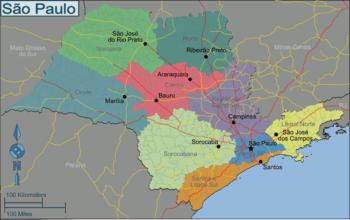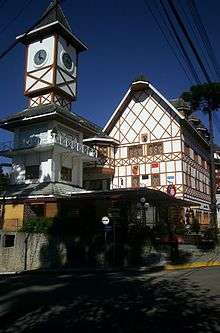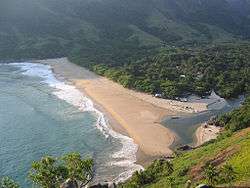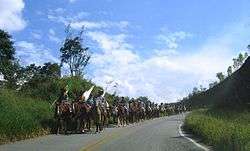São Paulo (state)
São Paulo is a state in the southeast of Brazil. It is undoubtedly the country's economic powerhouse, contributing alone to one third of the Brazilian GDP. Among visitors, the state is more well-known for its huge and somewhat chaotic capital, São Paulo. However, the vast countryside of the state offers much else to be enjoyed, including rainforest-surrounded amazing beaches, a rich Italian and Japanese heritage blended seamlessly with local (caipira) culture, and prosperous, relaxing small towns that can make you forget that you are in a developing country.
Regions

| Northwest São Paulo rivers at their best, and a hugely popular hot spring waterpark. |
| North With the country's most famous draft beer and largest rodeo festival. |
| West Quiet towns and strong marks left by Japanese immigration. |
| Central A transition area between the industrialized east and the rural north and west of the state. |
| Campinas Region The bustling metropolis of Campinas, cozy mineral spring towns and traditional farms founded by European immigrants. |
| Sorocabana The state's cycling capital Sorocaba, the tranquility of the Jurumirim and Barra Bonita reservoirs, the canyons and waterfalls of the Itararé Valley. |
| Santos and South Coast The coastal metropolis of Baixada Santista side-by-side with the UNESCO-protected rainforest area of the Ribeira Valley. |
| Grande São Paulo The sprawling metropolitan area of the largest city in the Southern Hemisphere. |
| North Coast Beach resort getaways and, inland, some charming cities of the Paraíba Valley. |
Cities

- 🌍 São Paulo - The huge, prosperous and cosmopolitan capital of São Paulo, with its large number of museums, theaters, restaurant, malls, offices and annual and international events. It's one of the best cities for business tourism in the world
- 🌍 Campinas - The second largest metropolis in the state, one of the country's main centers of technology and scientific research, and a great place to party
- 🌍 Santos - Containing the largest port in Brazil, a valuable historical heritage and testimonies to some of the most glorious moments of Brazilian football
- 🌍 São Luiz do Paraitinga - Town famous for its XIX century historical center, its traditional Carnaval and for its ecotourism options
- 🌍 Aparecida - Where millions of Christians flock every year to visit the largest Catholic temple in the World outside the Vatican
- 🌍 Iguape - A Colonial-era town with a lovely historic center surrounded by unspoiled beaches and nature
- 🌍 Campos do Jordão - A lovely mountain city covered by lots of Brazilian Pines, with a nice climate, European architecture, cobblestone streets, and small shops. The city is famous for its yearly Winter Classical Music Festival
- 🌍 São Sebastião - Coastal town with the state's most famous beach, Maresias, a pleasant historic center and the entry point to Ilhabela
- 🌍 Ribeirão Preto - Largest city of the northwest half of the state, with valuable historical buildings and the country's most famous chopp
- 🌍 Presidente Prudente - Capital West Paulista, the city offers visitors the experience of a city within the country, with the facilities of large cities.
Other destinations
- 🌍 Jacupiranga Conservation Units - Previously called "Jacupiranga State Park", it contains a large original Atlantic rainforest reserve, the famous "Caverna do Diabo" (Devil's Cave) and the beautiful Lagamar de Cananéia
- 🌍 Alto Ribeira State Touristic Park - One of the largest original Atlantic rainforest reserves of the country, hence with large animal biodiversity, also with the highest concentration of caves in the World
- 🌍 Serra do Mar State Park - A huge reserve facing the coast, composed mostly of regenerating Atlantic rainforest, thus with smaller biodiversity than the Jacupiranga and Alto Ribeira reserves. Famous for its marvelous noncontiguous beaches
- 🌍 Paulista Water Circuit - A collection of calm mineral spring towns over the Serra da Mantiqueira mountain range
- 🌍 Ilhabela - An arquipelago containing mostly intact nature, several savage trails and beaches, and the country's premier sailing destination
- 🌍 Serra da Bocaina National Park - A large rainforest reserve located between São Paulo and Rio de Janeiro, with both original and regenerating Atlantic rainforest
- 🌍 Ubatuba - Municipality with dozens of kilometers of coast with dozens of beaches surrounded by rainforest, many completely deserted outside (and some even inside) the peak season. Also one of the country's main surfing destinations
- 🌍 Brotas - Municipality popular for practitioners of radical sports, including rafting, ziplining, canopy and rapel
Understand
Geography
The state of São Paulo has an area of approximately 248,800 km² (95,700 mi²), and a population of about 40 million (21.5% of the population of Brazil), which makes it the most populous country subdivision in the Western Hemisphere. The climate of São Paulo is tropical to subtropical, altitude being the largest contributor to what variation there is. The capital, São Paulo, barely outside the tropics in the south of the state and about 800 meters (2,600 feet) above sea level, has daily minimum and maximum averaging about 19°C and 28°C (66°F and 82°F) respectively at the warmest time of year and about 12°C and 22°C (54°F and 72°F) respectively at the coolest time of year. Temperatures reach around 33°C (91°F) on the hottest days and fall as low as 5°C (41°F) on the coldest nights. In the low-lying northwest of the state, temperatures average around 4°C (7°F) higher.
Economy
São Paulo state is responsible for approximately one-third of Brazilian GDP. Its economy is based on machinery, the automobile and aviation industries, services, financial companies, commerce, textiles, orange growing, sugar cane and coffee production.
Wealth is unequally distributed in the state, however. The extreme south of the state (the Itararé Valley and the Ribeira Valley) and the extreme east (the Historical Valley circuit, in the Paraíba Valley), have been for a long time in economical stagnation and are significantly poorer than the rest of the state. Metropolitan areas and larger cities such as Ribeirão Preto typically have a number of very poor suburbs (the so-called periferia).
Demography

São Paulo has the most diverse population of Brazil. Strong immigration in the late 19th century and early 20th century brought people from all over the world to the state. The main ethnic group in São Paulo are the Italians. There are about 15 million people of Italian descent living in the state, and it is one of the largest concentration of Italians outside Italy. São Paulo always had a large Portuguese population, since the 16th century, though most Portuguese arrived in the state in the early 20th century. The Spanish population is also large, with some 7 million people of Spanish descent in the state. The Arab population, mainly Christians of Lebanese or Syrian descent are 5 million, and people of German descent are about 3 million.The population of Afro-Brazilian descent in São Paulo grew in the last decades, due to strong migration of people from northeastern Brazil, which used to concentrated most of them. People of Asian descent make up 10% of the population, most of them of Japanese descent. São Paulo has the largest Japanese population outside of Japan. Other Asian groups include Chinese and Koreans.
Talk
The São Paulo state has two main accents of the Portuguese language: the Paulistano accent (often incorrectly called Paulista accent) predominates in the Grande São Paulo and surrounding area, and the Caipira accent predominates in the central and western parts of the state. In both accents, the word você is always used to say "you", instead of tu.
However, due to the large migration from the Northeast of the country during the second half of the XX century, accents of this region of Brazil can be commonly heard in large cities, especially in the suburbs.
Get in
Get around
São Paulo is the state with the largest system of transportation in Latin America, comprising roads, railways, fluvial lanes, airports, river and sea ports. The city of São Paulo also boasts of a metro and a suburban railway system.
By car
São Paulo's state roads are reputedly the best and safest roads of Brazil, although they have also by far the most expensive tolls. Expect to spend in tolls up to 60% of what you spend in fuel. São Paulo's federal roads have cheaper tolls and inferior quality, although they are not particularly unsafe. Differently from other parts of Brazil, Paulistas commonly refer to the roads by the long name instead of the short name; for instance, you will be more promptly understood by a local if you mention "Rodovia Castelo Branco" instead of "BR374".
By bus
Intercity buses, provided by private operators, are generally a comfortable, efficient and reasonably priced way of moving between cities of the state, and competition between operators is intense. Unfortunately, finding information about the available buses between two cities is not always a trivial task. The website Buscaonibus provides information about companies, prices and timetables, but the information about smaller cities is often missing. An alternative is to find the telephone number of the intercity bus terminal (Rodoviária) of the origin city, ask about the available operators to your destination, and call or find the website of the operator.
Reservation in advance is advised when going to or from smaller cities, during holidays, or when you are going to some large event. In the Grande São Paulo, try to avoid taking intercity buses on peak hours otherwise you may lose a lot of time in traffic.
By train
Once the most popular means of transport in the state, passenger trains have being almost extinct, although there are projects to reactivate some rail links. Other than the metropolitan trains inside the Grande São Paulo area, the only surviving regular line is the slow CPTM train linking Grande São Paulo to Jundiaí. There are also a number of weekend-only touristic train rides, linking for instance Campos do Jordão to Pindamonhangaba, and Campinas to Jaguariúna.
See
- The Atlantic Forest South-East Reserves — a UNESCO World Heritage site
Historical heritage
Although the São Paulo state was settled by the Portuguese already in the XVI century, its real economical development started in the XIX century and early XX century (with the boom of coffee farming). Despite the loss of many precious constructions of this era (due to the accelerated industrial and populational growth of the XX century and the lack of regard of Brazilian Modernists for all non-colonial and non-modernist architecture), many remarkable constructions of the coffee farming period are still preserved and protected.
They can be found in the city centers of most medium and large-sized cities of the state, like the São Paulo historic center. Some smaller cities and villages were able to maintain a considerable heritage from this period, including Sousas, Joaquim Egídio, Amparo, São Luiz do Paraitinga and Paranapiacaba.
Towns that contain considerable heritage from the Colonial (XVI-early XIX centuries) period are few, like Iguape and Santana de Parnaíba, although Colonial era churches, buildings and landmarks can be found in several places.
Beaches

São Paulo's beaches lack the glamour of the ones in Rio de Janeiro or Santa Catarina, or the perfect weather of the beaches in the Northeast of the country. Yet the state offers several wonderful and/or unspoiled beaches, many surrounded by Atlantic rainforest, which are definitely worth a visit if you want to go off the beaten path of foreigner tourists.
It is a good idea to understand the weather before planning your trip. Due to the São Paulo coast's humid subtropical climate, during summer months (December to March), precipitation levels are higher, and storms sometimes occur. Winter (June to September) is the driest season, but it may be a bit cold to enjoy a beach. Spring and autumn generally offer a good compromise of pleasant temperatures and only a moderate chance of rain.
Do
- Bonete Jungle Trail (Trilha do Bonete) – A beautiful 2 day jungle trail on Ilhabela island with picturesque waterfalls, refreshing river pools, beautiful beaches, and flora and fauna of the Atlantic rain forest.
Ecotourism and radical sports
The São Paulo state is gifted with beautiful nature and landscapes, and you don't even need to go far from the concrete jungle of the state capital to see them. The east of the state contains the largest portion of the Atlantic South-East Reserves, a World Natural Heritage Site formed by the Serra do Mar and the Vale do Ribeira, and the north of the state contains about 30% of the Serra da Mantiqueira mountain range. There are plenty of options of climbing, hiking, trekking, rafting, paragliding, parachuting and even cave exploring in the vicinity of the state.
Culture and events

Prior to the immigrations waves that started in the late XIX century, São Paulo's dominant culture was the caipira culture, with strong Roman Catholic influence. Caipira traditions remain strong in the countryside and in smaller cities, celebrating events like the Festa do Divino Espírito Santo (Festival of the Divine Holy Ghost), the Festa de São Benedito (Festival of Saint Benedict), and performing the yearly Romaria (Catholic pilgrimage) to Pirapora de Bom Jesus or Aparecida. Some traditions remain even in large cities, like the quermesses (festivals celebrated in the month of june around churches, with stalls selling food and allowing people to play games).
The sertanejo music, part of the Caipira culture, remains widely popular in the state, although modern sertanejo, with strong pop influence, has little in common with the original sertanejo music (called sertanejo de raíz). The largest sertanejo festivals are the rodeos, the most famous of the state (and in fact, of the entire Latin America) being celebrated in Barretos. Americana and Jaguariúna have also popular rodeo festivals.
Immigration left a strong mark in the culture of São Paulo, with many festivals in the countryside and in the state capital being organized by immigrant communities, like the Festa de Nossa Senhora Acheropita (São Paulo), the Expoflora (Holambra) and the Festa da Uva e do Vinho (Vinhedo). The blending between cultures is also remarkable; it is common, in quermesses, to find stalls selling Italian, Japanese, Portuguese and Arab snacks in addition to Caipira snacks.
Eat
São Paulo's traditional cuisine is the caipira cuisine, with similarities and common dishes to the cuisine of Minas Gerais and Goiás, using ingredients like flour, brown beans, cassava, pork and beef. Some dishes include leitão à pururuca, virado à paulista, feijão tropeiro and vaca atolada. Desserts of the caipira cuisine include the pamonha, paçoca de amendoim and pé-de-moleque. Caipira restaurants are easier to find in the countryside of the state, as the state capital has a more international and pan-national range of restaurants.
Food native from the state, but not part of the caipira cuisine, include the bauru (Brazilian bread with roastbeef, tomato, pickles and melted cheese) and the torta holandesa (literally "Dutch pie", a dessert that uses black and white chocolate, cream cheese, vanilla and cookies).
With about 12 million of Italian descendants, it is no surprise that Italian food is ubiquitous in the São Paulo state, with cantinas and pizzerias being found practically everywhere. São Paulo pizzas use less tomato sauce than their Italian counterparts, and frequently use typical Brazilian ingredients such as catupiry, heart of palm and dried meat.
Drink

São Paulo's most famous native drink is the caipirinha, a cocktail made of cachaça, sugar, lime and ice and popular all around the country. It is originary from the city of Piracicaba. The state's most famous native beer is undoubtly Antarctica, one of the most consumed beers in Brazil. In originated in 1888 in the state capital São Paulo, and is now brewed by AmBev.
Several local wineries, beer and cachaça brewers can be found in the countryside of the state, like in the Fruit Circuit, that includes the cities of Jundiaí, São Roque and Vinhedo.
Sleep
Stay safe
As of 2010, São Paulo is the Brazilian state with third lowest homicide rate, only behind Santa Catarina and Piauí. For a visitor, the risk of suffering from violent crime is higher at the metro areas (São Paulo, Campinas and Baixada Santista), where social inequality is higher, although crime is highly unevenly distributed in these areas. Smaller cities are generally safe for a visitor, but in poorer cities and neighborhoods, it is very wise to avoid displaying possessions and keeping a low profile.